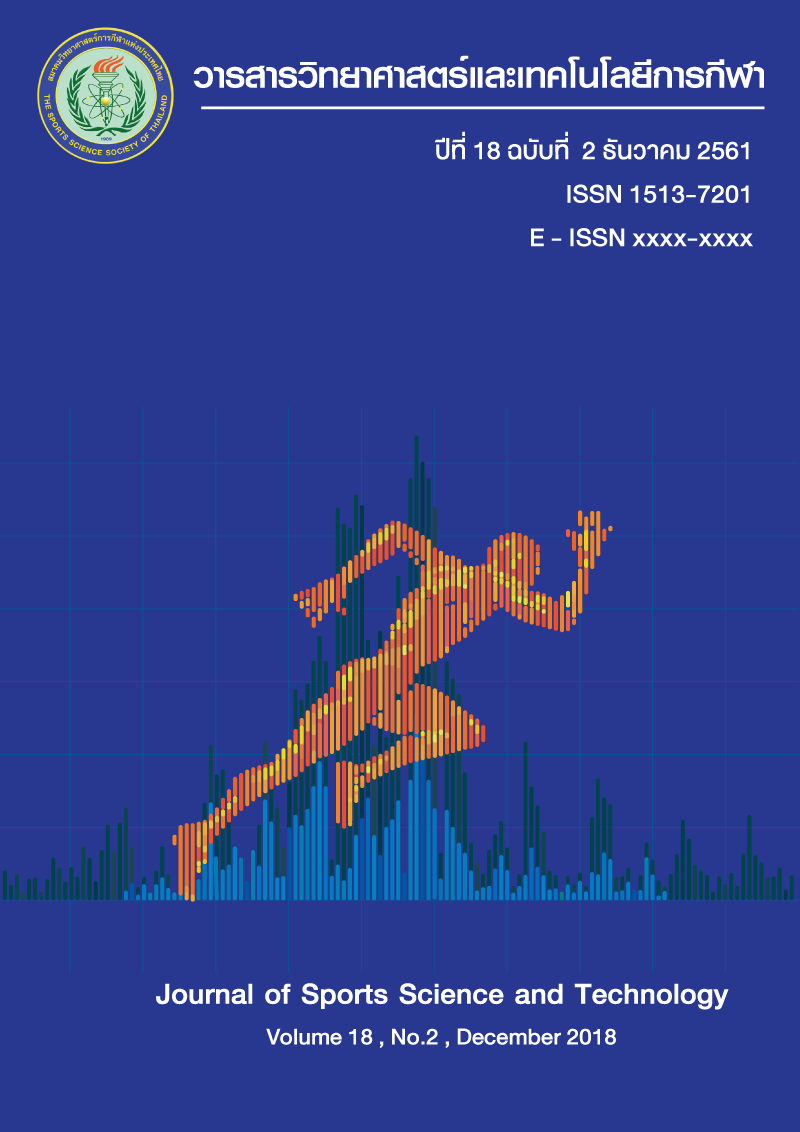THE EFFECT OF DIFFERENT RECOVERY DURATION ON COUNTERMOVEMENT JUMP AFTER REPEATED SPRINT ABILITY IN HEALTHY MALE AGED 18-25 YEARS
Keywords:
Recovery, Physical performance, Countermovement jumpAbstract
Declines in force output during physical performances are frequently caused by an accumulation of fatigue and therefore highly effective recovery techniques would enhance athlete performance. This study aims to determine the effect of different recovery duration on countermovement jump after repeated sprint ability tests in healthy male. Twenty one healthy male university students were randomly allocated to active 25-sec, 50-sec and passive 25-sec recovery. Participants performed two sessions of countermovement jump tests before and after completed repeated sprint ability (6 × 40 m) tests in which participants were either performed light stationary running or standing during recovery period by examining a number of variables, such as Countermovement jump height and time used for each single shuttle sprint. There were no statistically significant differences of countermovement jump height between groups throughout the recovery period (p > 0.05). But there was a statistically significant decrease of time used during 5th and 6th of shuttle sprint intervals of active 50-sec compared with passive 25-sec recovery (p < 0.05). In conclusion, the differences of recovery duration had no significant effect on countermovement jump height after repeated sprint ability test; however, study findings shown that light active 50-sec recovery tended to maintain the subsequent countermovement jump performances which were slightly superior to that observed earlier in other recovery strategies.
(Journal of Sports Science and Technology 2018; 18(2): 81- 89)
Keywords: Recovery, Physical performance, Countermovement jump
*Corresponding author: Thanawat KITSUKSAN Department of Physical Therapy, Faculty of Allied Health Science, Thammasat University, Pathumthani Thailand 12120 E-mail: Thanawat.k@allied.tu.ac.th
References
2. Impellizzeri FM, Rampinini E, Castagna C, Martino F, Fiorini S, Wisloff U. Effect of plyometric training on sand versus grass on muscle soreness and jumping and sprinting ability in soccer players. Br J Sports Med. 2008;42(1):42-6.
3. Brown J, Glaister M. The interactive effects of recovery mode and duration on subsequent repeated sprint performance. J Strength Cond Res. 2014;28(3):651-60.
4. Mika A, Mika P, Fernhall B, Unnithan VB. Comparison of recovery strategies on muscle performance after fatiguing exercise. Am J Phys Med Rehabil. 2007;86(6):474-81.
5. Larson LM, Smelter RM, Petrella JK, Jung AP. The effect of active vs. supine recovery on heart rate, power output, and recovery time. Int J Exerc Sci. 2013;6(3):180-7.
6. McArdle WD, Katch FI, Katch VL. Essentials of exercise physiology: Lippincott Williams & Wilkins; 2006.
7. Padulo J, Tabben M, Ardigo LP, Ionel M, Popa C, Gevat C, et al. Repeated sprint ability related to recovery time in young soccer players. Res Sports Med. 2015;23(4):412-23.
8. Castagna C, Abt G, Manzi V, Annino G, Padua E, D'Ottavio S. Effect of recovery mode on repeated sprint ability in young basketball players. J Strength Cond Res. 2008;22(3):923-9.
9. Padulo J, Tabben M, Attene G, Ardigo LP, Dhahbi W, Chamari K. The Impact of Jumping during Recovery on Repeated Sprint Ability in Young Soccer Players. Res Sports Med. 2015;23(3):240-52.
10. Delevatti RS, Alberton CL, Kanitz AC, Marson EC, Kruel LFM. Vertical ground reaction force during land and water-based exercise performed by patients with type 2 diabetes. Medicina Sportivâ. 2015;10(1):2501-8.
11. Limroongreungrat W, Kamutsri T. Comparison of vertical jump performance between female Thai national and youth national valleyball players. Journal of Sports Science and Technology (Thailand). 2014;14(12):17-24.
12. Linthornea, NP. Analysis of standing vertical jumps using a force platform. Am J Phys. 2001;69(11):1198-204.
13. Dupont G, Blondel N, Berthoin S. Performance for short intermittent runs: active recovery vs. passive recovery. Eur J Appl Physiol. 2003;89(6):548-54.
14. Selmi MA, Haj SR, Haj YM, Moalla W, Elloumi M. Effect of between-set recovery durations on repeated sprint ability in young soccer players. Biol Sport. 2016;33(2):165-72.
15. Vaile J, Halson S, Graham S. Recovery review - science vs. practice. J Aust. Strength Cond. 2010;Supplement 2:5-21.
16. Toubekis AG, Douda HT, Tokmakidis SP. Influence of different rest intervals during active or passive recovery on repeated sprint swimming performance. Eur J Appl Physiol 2005; 93(5-6): 694-700.
17. Menzies P, Menzies C, McIntyre L, Paterson P, Wilson J, Kemi OJ. Blood lactate clearance during active recovery after an intense running bout depends on the intensity of the active recovery. J Sports Sci. 2010;28(9):975-82.






